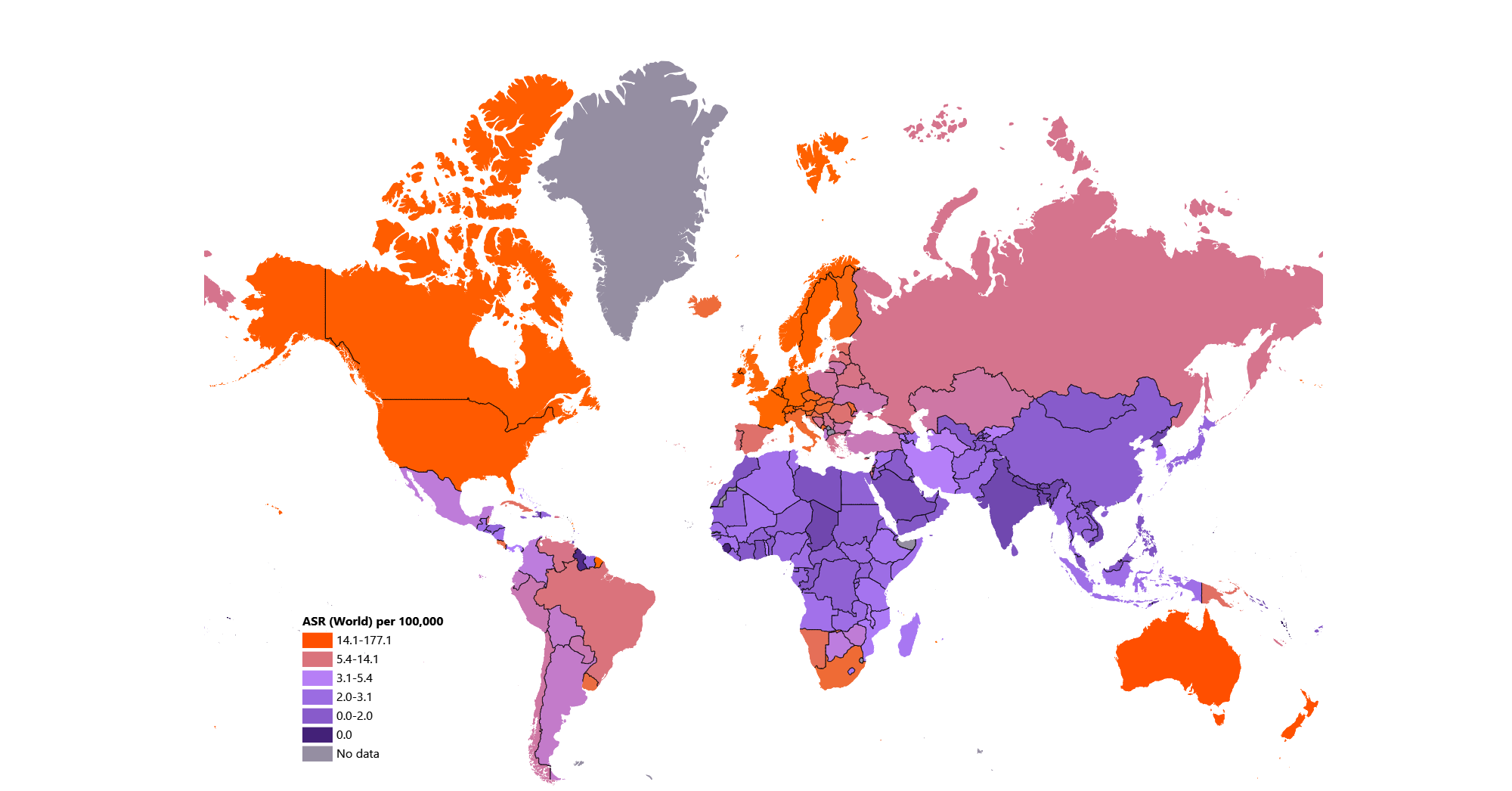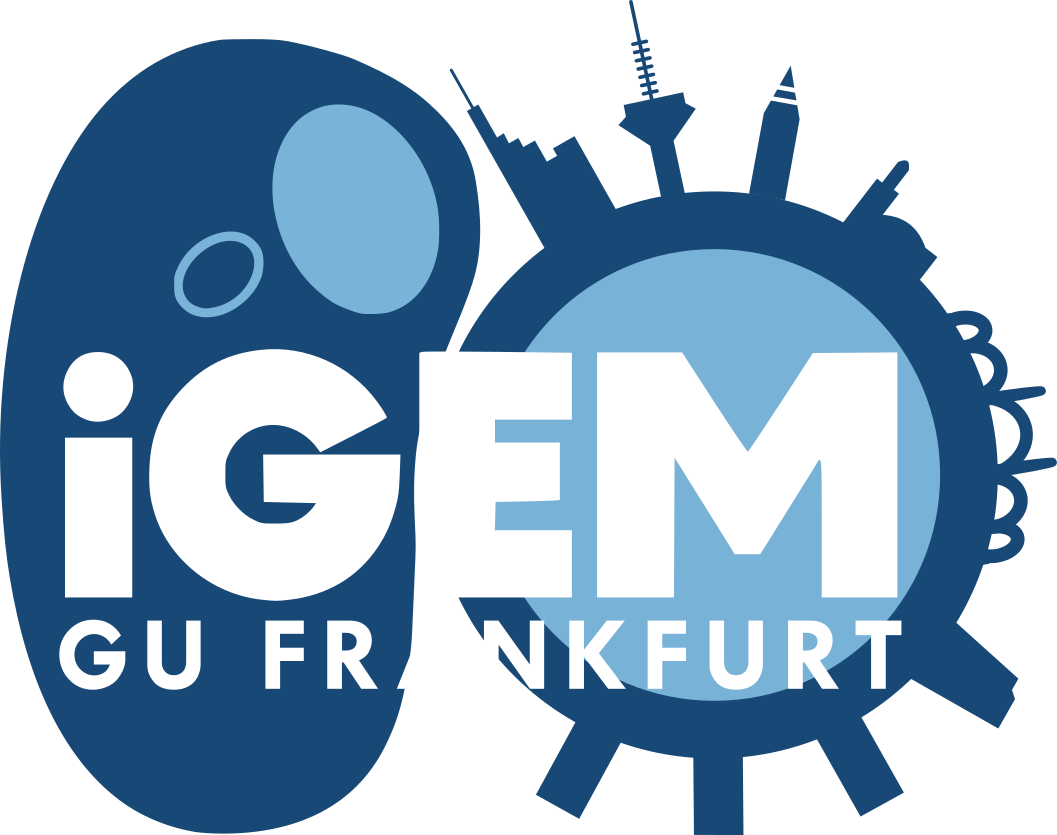Project Outline
The iGEM (International Genetically Engineered Machine) competition is an annual international competition that brings together teams from around the world to design, build, and test novel biological systems using synthetic biology. The competition provides a platform for students to showcase their creativity, scientific and engineering skills, and entrepreneurship by addressing real-world problems through biological solutions.
Our mission with our project is the sustainable production of natural sunscreen compounds to protect our skin from cancer and reefs from toxic UV filters. With NRPS bioengineering in heterologous Escherichia coli host, we are aiming to modify our compounds to cover a broader UV spectrum or shift the absorption wavelengths to additionally provide UVB protection.

Figure 1:
Age-standardized incidence rate per 100,000 people of melanoma and non-melanoma skin cancer, via WHO
Conventional sunscreens are effective for skin protection against UV radiations of the sun. However, those sunscreens have detrimental effects on the environment, especially on coral reefs. Chemical and physical UV filters contribute to coral bleaching and completely disrupt marine ecosystems (Miller et al., 2021).
Naturally derived photoprotective compounds from organisms like algae, fungi or cyanobacteria present a promising alternative to toxic UV filters of sunscreens. Mycosporine-like amino acids (MAAs) are gaining a significant amount of importance when it comes to natural and reef-safe sunscreen compounds. Their various bio-active characteristics like anti-UV, anti-aging, anti-inflammatory, antioxidant and wound healing properties (Singh et al., 2021) make them highly attractive for the cosmetic and pharmaceutical industry. The highest amounts of MAAs have been found in red algae species (Sun et al., 2020).
Helioguard 365 is a commercially available MAA sunscreen ingredient produced by extraction of the MAA compounds Porphyra-334 and Shinorine from red macroalgae Porphyra umbilicalis (Mibelle AG Biochemistry, Switzerland). The aforementioned MAAs were found to be the most dominant compounds in red macroalgae extraction studies, together with Palythine and Asterina-330 (Sun et al., 2021). However, they only absorb in the range of UVA rays (320 – 334 nm) (Rastogi et al., 2020). This makes it impossible for MAA sunscreens to enter the German market, since the EU commission requires a minimum sun protection factor (SPF) of 6 for UVB filters in sunscreen. Another common issue making the extraction of MAAs difficult for mass industrial applications is their chemical characteristics. Pure separation and extraction methods demonstrate difficulties due to MAAs being highly soluble in mobile phases of liquid phase analysis.
Additionally, the structural variations between MAAs makes the extraction and separation approaches more complex. It is even more challenging to distinguish different MAAs since factors such as pH or polarity of the extraction solvent influence their solubility and absorbance properties. In addition to extraction methods from natural sources being counterproductive, the aquacultures to obtain masses of algae are expensive and require long cultivation periods (Peng et al., 2023).
By locally producing MAAs in heterologous Escherichia coli host, SOLAR offers a sustainable and efficient alternative to currently manufactured sunscreens. Our product additionally provides UVB protection, making it a promising sunscreen alternative for people all over the EU. With NRPS bioengineering we aim to modify our MAA compounds, making them absorb a broader spectrum or shorter wavelengths of UV rays. Our cell-free lysate synthesis approach makes it easy for hands-on use of the MAA compounds, since complex and time-consuming extraction and purification steps can be skipped. SOLAR is the future of sustainable reef-safe sunscreen making our product highly desirable for mass industrial applications.
Citations
Miller, I.B., Pawlowski, S., Kellermann, M.Y., Petersen-Thiery, M., Moeller, M., Nietzer, S., Schupp, P.J., 2021. Toxic effects of UV filters from sunscreens on coral reefs revisited: regulatory aspects for “reef safe” products. Environ. Sci. Eur. 33, 74. https://doi.org/10.1186/s12302-021-00515-w
Peng, J., Guo, F., Liu, S., Fang, H., Xu, Z., Wang, T., 2023. Recent Advances and Future Prospects of Mycosporine-like Amino Acids. Mol. Basel Switz. 28, 5588. https://doi.org/10.3390/molecules28145588
Rastogi, R.P., Madamwar, D., Nakamoto, H., Incharoensakdi, A., 2020. Resilience and self-regulation processes of microalgae under UV radiation stress. J. Photochem. Photobiol. C Photochem. Rev. 43, 100322. https://doi.org/10.1016/j.jphotochemrev.2019.100322
Singh, A., Čížková, M., Bišová, K., Vítová, M., 2021. Exploring Mycosporine-Like Amino Acids (MAAs) as Safe and Natural Protective Agents against UV-Induced Skin Damage. Antioxidants 10, 683. https://doi.org/10.3390/antiox10050683
Sun, Y., Han, Xiu, Hu, Z., Cheng, T., Tang, Q., Wang, H., Deng, X., Han, Xu, 2021. Extraction, Isolation and Characterization of Mycosporine-like Amino Acids from Four Species of Red Macroalgae. Mar. Drugs 19, 615. https://doi.org/10.3390/md19110615
Sun, Y., Zhang, N., Zhou, J., Dong, S., Zhang, X., Guo, L., Guo, G., 2020. Distribution, Contents, and Types of Mycosporine-Like Amino Acids (MAAs) in Marine Macroalgae and a Database for MAAs Based on These Characteristics. Mar. Drugs 18, 43. https://doi.org/10.3390/md18010043

